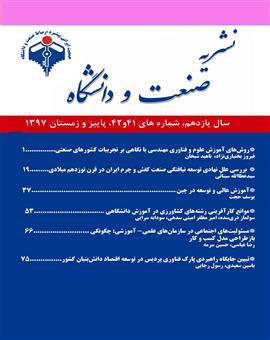آموزش عالی و توسعه در چین
محورهای موضوعی : عمومی
1 - دانشکده مهندسی مکانیک دانشگاه تربیت مدرس
کلید واژه: آموزش¬عالی, ثبت اختراع, جهانی, تحقیق و توسعه, مدل, موسسات آکادمی,
چکیده مقاله :
در این مقاله تجربیات بیش از دو سال مسئولیت رایزنی علمی در چین با تکیه بر دانشگاه ها و ارتباط آن ها با صنعت ارائه شده است. در ابتدا تاریخچه و روند توسعه آموزش عالی و نیز دستاوردهای علمی دانشگاه ها ارائه وبر دستاوردهای دانشگاه ها، توانمندی ها و انتشارات علمی چین و تا حدودی مقایسه با دنیا بحث شده است. درمورد برخی از مراکز علمی که در ساخت امروز و فردای چین نقش موثری دارند، از جمله آکادمی علوم چین نیز توضیحات مختصری داده شده و در نهایت به فعالیت-های علمی مشترک بین صنعت و دانشگاه یعنی ثبت اختراع و مقالات مشترک پرداخته شده است.
This article presents the experiences of more than two years of scientific advisory responsibility in China, relying on universities and their relationship with industry. First, the history and development process of higher education as well as the scientific achievements of universities are presented on the achievements of universities. China's scientific capabilities and publications, and to some extent comparisons with the world, are discussed. Some of the scientific centers that play an important role in building China today and tomorrow, including the Chinese Academy of Sciences, are briefly described, and finally, the joint scientific activities between industry and academia, namely patents and joint papers.
1. جواهری، منوچهر. مسعودی، عصمت (1382) اولویتبندی شاخصهای دسترسی به فرصتهای برابر در توسعه آموزشهای علمی-کاربردی کشور. فصلنامهی آیندهپژوهی مدیریت. دانشگاه آزاد اسلامی واحد علوم و تحقیقات. ۱۵ (4) 16-1
2. بررسی تطبیقی سیاست¬های علوم، تحقیقات و فناوری در کشورهای مختلف، دبیرخانه شورایعالی عتف، 1387.
3. Philbin, S. (2008). “Process Model for University -Industry Research Collaboration”, European Journal of Innovation Management, 11(4), pp. 488 -521.
4. Hughes, A., Kitson, M., Abreu, M., Grinevich, V., Bullock, A. & Milner, I. (2010), Cambridge Centre for Business Research Survey of Knowledge Exchange Activity by United Kingdom Businesses, UK Data Archive Study No.6464.
5. روند مهاجرت تحصیلی دانشجویان در جهان (فرصت-ها و تهدیدها)، شورایعالی انقلاب فرهنگی، 1396.
6. نقشها و ارتباطات دانشگاه، صنعت و دولت در توسعه فناوری، شورایعالی انقلاب فرهنگی، بهار 1394.
7. Innovation policy in seven candidate countries: the challenges,volum2.7, Innovation Policy Profile:Turkey, Technology Development Foundation of Turkey,2003
8. Auntin, F. Batruch, A. and Butera, F. (2015) Social justice in Education: how the function of selection in educational institutions predicts support for (non)egalitarian assessment practices. Journal of Original Research. 6: 1-13
9. Brinkman, P.T. (1992) ``Factors That Influence Costs in Higher Education’’, New Directions for Institutional Research, No. 75. Fall.
10. Expanding Its Global Reach Trough Branding, In-Country and Online. In Dean. E Neubauer, K. Mok, J. Jiang (Eds) The Sustainability of Higher Education in an Era of Post-Massification. (pp: 43-58) London and New York, Routledge. Systems Perspective, a Dissertation for Doctor of Philosophy, University of Wisconsin-Milwaukee.
11. Froomkin, J. (1993), ``Research Universities Face Difficult Choices’’, New Directions for Institutional Research, No. 79. Fall.
12. Blanden, J. and Machin, S. (2004) Educational Inequality and the Expansion of UK Higher Education, Scottish Journal of Political Economy. N0: 51. Vol: 2. Pp: 230–249.

